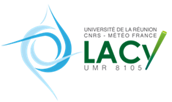With its Overseas Territories, France is present in three of the seven cyclonic basins (North Atlantic, South Pacific and Indian Ocean). The local authorities are regularly faced to cyclonic crisis situations whose frequency should possibly increase with climate change. However, they currently don’t have any tools dedicated to cyclone-induced inundation forecast at their disposal.
SPICy is a research project that aims at realizing an experimental cyclone-induced marine and river floods forecasting system for the French Overseas Territories.
Implementation of such a system requires handling the following challenges : What model developments are required to extend the hazard information from meteorological to marine and river floods in French Overseas islands context? Which developments are relevant considering the uncertainties associated to meteorological forecasts? What is the good compromise between resolution, precision and computation time to provide information in time for meaningful actions to be taken? What are the concrete needs of the decision-makers? At which scale? On which support? How to integrate and present the uncertainties belonging to each level of the forecasting process?
Thus, the project will address some limitations of the current forecasting system of Météo-France RSMC La Réunion and explore state of the art techniques on cyclones and induced impacts forecast issues:
- High resolution meteorological modelling taking into account orography and real-time data assimilation.
- Management of uncertainties of the cyclone track and intensity forecast through ensemble tracks generation.
- Real-time modelling of cyclone-induced phenomenon leading to marine inundation (swell, storm surge, wave breaking, overflowing and overtopping, etc.) in a limited resources environment.
- Evaluation of river flooding risk in cyclonic conditions for different forecast times and integration of the combined effects of continental and coastal phenomenon for the assessment of inundation risk in coastal and river inlet environments.
- Management of computation time optimization.
- Consideration of users’ needs and reflection about the relevant supports of communication for decision making.
For the project, the selected pilot site is Reunion Island. This choice is motivated by the high frequency of cyclones affecting the island every year and the decisive role of Météo-France in the Indian Ocean basin as official RSMC. Two scales will be investigated: the scale of the island and the scale of 3 local sites (Sainte Suzanne, Saint Paul and the coastal road RN1).
Beyond the improvement, implementation and combination of different physical models, the novelty of the project will also lie in methodological developments to properly account for the end-users needs and find the best way to communicate actionable information to decision-makers. The consistency between the project developments and the real needs of users will be ensured by a strong implication of the crisis management actors (EMZPCOI; DEAL-SPRINER-CVH; Région-DRR) all along the project through their participation in a user’s group. The demonstrator developed during the project will be tested during two crisis exercises.
Dernière mise à jour le 22.09.2016











